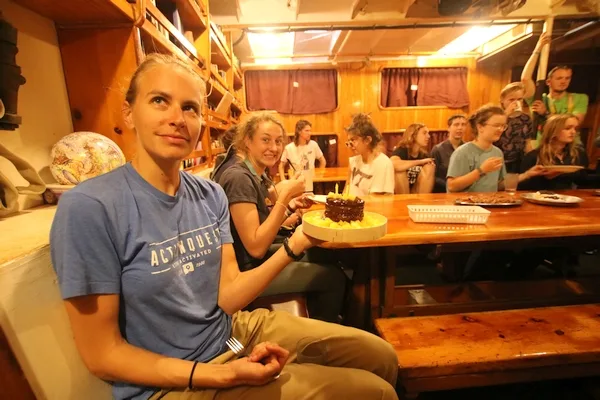News
Offshore for Shore

Aidan Young, Duke University, Gap Year Student
Ship’s Log
Present Location
39° 58.608’ N x 071° 15.423’ W
Ship’s Heading, Speed and sail plan
Hove-To, Mains’l (First Reef)
Weather
Clear skies, Wind from SSW, 2 foot waves from SWxS
Hello to everyone reading this blog. It’s been a long, beautiful 24 hours on the Cramer. Just about a day ago I was settling into a beautiful Evening Watch—1900 to 0100. On lookout and the helm, I got a pretty excellent view of a full night sky. As a New Yorker, I don’t see much of the stars at all, but I got the sense that this was an especially good night by any metric. The Milky Way was on full display and I caught sight of more than a few shooting stars. On that watch we caught our first myctophids in our neuston tow, which will be good data points for many of our projects.
 Setting the Tops’l.
Setting the Tops’l.
I slept through most of the next morning, though I was told the sunrise was also beautiful, and awoke to a clear, warm day—the first of the trip that made me consider wearing shorts. My assignment for afternoon watch (1300-1900) was to be Assistant Engineer, so I got to work with JC, our Chief Engineer, today. We spent much of the afternoon performing weekly maintenance on the various valves on the ships. We also turned off our watermakers, which turn the seawater around us into freshwater, as we had filled up our tanks. These watermakers can turn salt water into freshwater at a whopping rate of 45 gallons/hour!
At our 1400 class, we received a weather report from Campbell, Max, and Megan, a navigational report from Yoela and Audrey, and a science report from Becca, Raechel, and Logan. During class we also practiced setting the tops’l, which is the higher of the two square sails on the foremast.
At 1600, we celebrated Carolyn’s, our 2nd mate, birthday! We had an appropriate afternoon snack to celebrate, a chocolate pineapple cake, along with a birthday song. Many compliments to Katey, Adam, and Sara in the galley for making that treat.
To briefly explain the watch system, the day is broken into 4 6-hour watch times: Morning Watch (0700-1300), Afternoon Watch (1300-1900), Evening Watch (1900-0100), and Dawn Watch (0100-0700). There are 3 watch groups—A, B, and C—that cycle through the watch times. In practice, this means that each watch group does every watch time every three days. A is relieved by B, B is relieved by C, C by A, ad infinitum. I figure all of you reading at home may
already be familiar, but that it would be good to explain as I am sure these different watches will be referenced almost every day going forward.
Being out at sea, at night or during the day, is magical. For most of today, there wasn’t even another ship in sight. Nothing but the wind, the sky, the sun, and the Cramer. It’s difficult to put into words, but the effect it has is very calming and relaxing. Especially in the turbulence of recent times and of very recent weather patterns, I’ve found the past 36 hours to be to reflect, on lookout, by reading, or by enjoying a sunny afternoon with friends with a furled sail as our cushion.
– Aidan Young, Duke University Gap Year Student
P.S. from Carolyn: Happy Birthday Daddy! Love you lots and lots.
P.S. from Aidan: To my family back home, I love and miss you all.